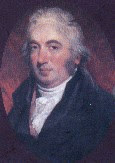François Nicolas
Henri
Racine de Monville
Born: 4 October 1734, Paris
Died: 9 March 1797, Paris – Aged 64
Portraits: No known portraits
“One of the most handsome eligible bachelors in Paris. He was 5
feet 8 inches tall and looked like a god...his torso and legs would have made
Antinous envious…his head was a bit too small, but still attractive”. Dufort de Cheverny , p. 29.
|
John Fuller
Born: 20 Feb 1757, North Stoneham, Hampshire
Died: 11 April 1834, 36 Devonshire Place, London – Aged 77
Portraits: Painting by Henry Singleton 1806; marble bust by Sir Francis
Leggatt Chantrey 1819; Medallion profile by William Wyon 1834; various
political cartoons.
“The Sussex
militia, of which the Duke of Richmond is Colonel, is now here. Mr. Fuller, a
very intimate young friend of Mr. Thrale, who is Captain of a Company
belonging to it, Dined with us. He is a Young man of a very large Fortune,
remarkably handsome, and very gay, sensible, unaffected and agreeable.” Fanny Burney, 1779.
|
Family
|
Family
|
Friends
|
Friends
|
Follies
Monville
designed and constructed the Désert de Retz between 1774 and 1789 as a Jardin Anglo-chinois, or
folly garden on his property at Chambourcy, Île-de-France.
Temple: Monville’s first folly was the Temple of Pan built in 1775; has a
Doric peristyle probably inspired by the first century BC Temple of Vesta at
Tivoli, Italy; dedicated to the god of nature hunting and rustic music an
appropriate choice for the Forêt de Marly which was reserved as a royal hunting ground. Remained in good condition until the
mid-20th Century. Complete reconstruction began in 2012, p 65.
Temple of
Repose: Monville’s
Temple of Repose consisted of no more than a facade positioned on the
circumference of a circle of trees. The
four rusticated columns of this
second temple remain; they have been
moved from their original location, now
part of a golf course adjacent to the garden.
Pyramid Ice House: It was constructed in
1781 and is similar in proportion to the Pyramid of Cestius in Rome, and appears
in an engraving by Giovanni Battista Piranesi, p 95. The entrance opened into a
6 m (18”) drop straight down. Interior is a huge chamber where ice was stored
in layers separated by straw; a sump at the bottom of the chamber pumped out melted water. Arguably it is the best preserved of
Monville’s buildings today. [In 1791-1792 an almost identical pyramid
icehouse, designed by Karl Gotthard Langhans, was built in the New Garden in
Potsdam, Germany.
Obelisk: It is thought to have been made of painted metal sheets attached
to a framework but nothing remains of it, p 94.
Chinese House: Remarkably the first Chinese private residence in Europe when it
was built in 1774. Monville lived there during the summer months until the
Column House was completed in 1782. Unfortunately, it collapsed in decay in the
1960s.
Column House: The exterior is designed to look like a truncated ruined column.
The interior spiral staircase is surrounded by oval, semi-oval, circular and
semicircular rooms on four floors above ground and a cellar below.
A Ruin: In 1783, Monville leased the ruined, Gothic church of -Saint-Jacques-et-Saint-Christophe from the Premonstratensian monks of the Priory of
Joyenval, p 99-100.
Other features: Hermitage, Open-air Theatre, Tartar’s Tent, Farm buildings, Greenhouses,
Orangery, Herb & Vegetable garden.
Source: Monville- Forgotten
Luminary of the French Enlightenment by Ronald W. Kenyon, Second Edition 2013.
For more on Monville and the Désert de Retz, including photographs and guided tours can be found on Ronald W. Kenyon's comprehensive website: http://desertderetz.info/ |
Follies
Fuller built a number of follies in and around his Rose Hill
estate at Brightling, Sussex, England between 1803 and 1830.
Temple: Known variously as the Greek or Rotunda temple, it was suggested
by Sir Humphry Repton in his plans for the garden of Rose Hill. It was built
around 1810 and is about 25 feet tall. It has a hollow base that was,
perhaps, used to store food and wine.
Pyramid: Fuller's pyramid is a 25 foot high mausoleum
built of ashlar in 1811, twenty-three years before his death. It stands in
the churchyard of St. Thomas à Becket, Brightling. It is said to be inspired
by the Pyramid of Cestius in Rome.
Obelisk: Known as the Brightling Needle, it is constructed of coursed stone, built in four sections with a stringcourse above each section. The obelisk itself is 65 feet (20 m) high. There is no inscription and it is thought to have been built either to commemorate Nelson's victory at Trafalgar in 1805 or in celebration of Wellington's victory over Napoleon in 1815 In 1985, extensive renovations were carried out to strengthen and stabilize the
obelisk
Tower: A 35’ high
folly thought to have been built in the late 1820s located off the
Brightling-Darwell Hole road, about a quarter mile south east of Fuller’s
estate.
Observatory: Designed
by Sir Robert Smirke in 1810
and completed in 1818 the Brightling Observatory was equipped with expensive
astronomy equipment including a Camera Obscura.
Sugar Loaf: Legend has it that Fuller made a bet that
he could see the spire of St Giles, Dallington from his house, Rose Hill.
When he realized that this was not true he had workmen hurriedly erect this
folly in order to win the bet.
A Ruin: In 1829, Fuller bought Bodiam Castle to save it from being completely dismantled by a Hastings building firm. It is arguably the most photographed castle in
the UK.
Other features: Code stone summerhouse, pillars, wall around Rose Hill estate,
steps and gate to churchyard of St Thomas a Beckett, Brightling.
Source: johnmadjackfuller.homestead.com |
Saturday, November 30, 2013
Monville & Fuller: a comparison
Subscribe to:
Posts (Atom)

